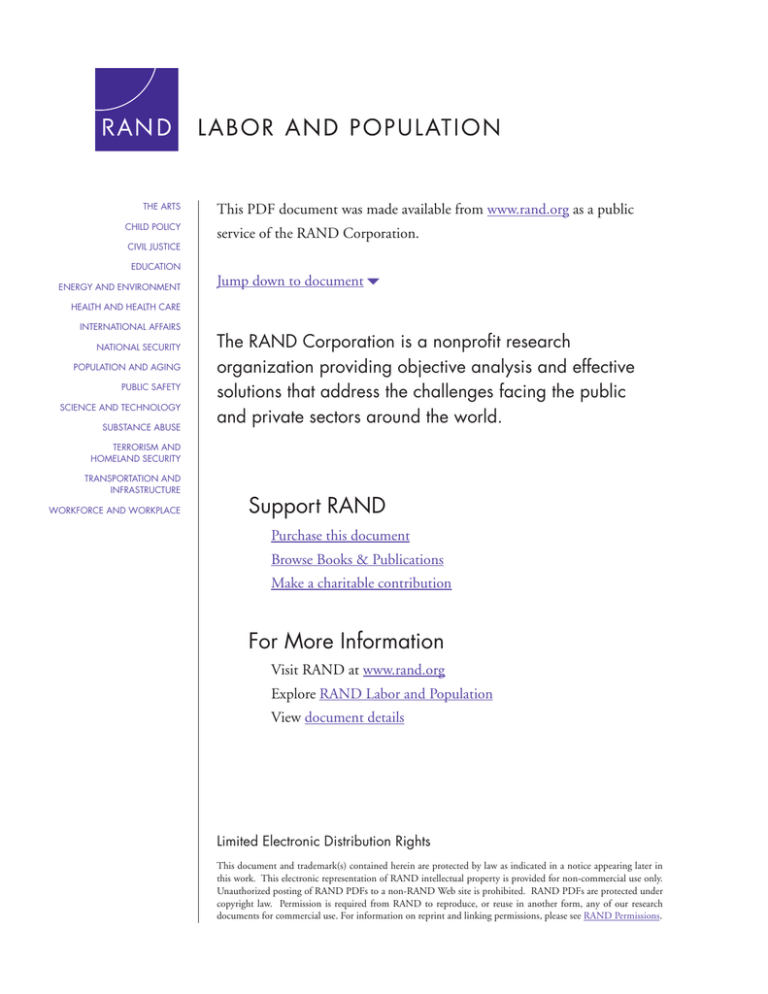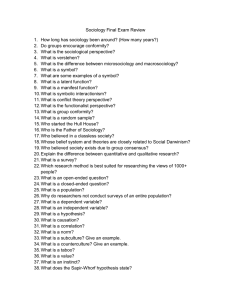
THE ARTS
CHILD POLICY
CIVIL JUSTICE
EDUCATION
ENERGY AND ENVIRONMENT
This PDF document was made available from www.rand.org as a public
service of the RAND Corporation.
Jump down to document6
HEALTH AND HEALTH CARE
INTERNATIONAL AFFAIRS
NATIONAL SECURITY
POPULATION AND AGING
PUBLIC SAFETY
SCIENCE AND TECHNOLOGY
SUBSTANCE ABUSE
The RAND Corporation is a nonprofit research
organization providing objective analysis and effective
solutions that address the challenges facing the public
and private sectors around the world.
TERRORISM AND
HOMELAND SECURITY
TRANSPORTATION AND
INFRASTRUCTURE
WORKFORCE AND WORKPLACE
Support RAND
Purchase this document
Browse Books & Publications
Make a charitable contribution
For More Information
Visit RAND at www.rand.org
Explore RAND Labor and Population
View document details
Limited Electronic Distribution Rights
This document and trademark(s) contained herein are protected by law as indicated in a notice appearing later in
this work. This electronic representation of RAND intellectual property is provided for non-commercial use only.
Unauthorized posting of RAND PDFs to a non-RAND Web site is prohibited. RAND PDFs are protected under
copyright law. Permission is required from RAND to reproduce, or reuse in another form, any of our research
documents for commercial use. For information on reprint and linking permissions, please see RAND Permissions.
This product is part of the RAND Corporation technical report series. Reports may
include research findings on a specific topic that is limited in scope; present discussions of the methodology employed in research; provide literature reviews, survey
instruments, modeling exercises, guidelines for practitioners and research professionals, and supporting documentation; or deliver preliminary findings. All RAND
reports undergo rigorous peer review to ensure that they meet high standards for research quality and objectivity.
Sanctions in the
CalWORKs Program
Jacob Alex Klerman, Jane McClure Burstain
Prepared for the California Department of Social Services
LABOR AND POPULATION
The research described in this report was conducted by RAND Labor and Population under
a contract with the California Department of Social Services (CDSS). The views expressed
herein are those of the authors and do not necessarily reflect the official position of the
CDSS.
Library of Congress Cataloging-in-Publication Data
Klerman, Jacob Alex.
Sanctions in the CalWORKS program / Jacob Alex Klerman, P. Jane McClure Burstain.
p. cm.
Includes bibliographical references.
ISBN 978-0-8330-4233-0 (pbk. : alk. paper)
1. Aid to families with dependent children programs—California. 2. Welfare recipients—California.
3. California Work Opportunity and Responsibility to Kids (Program) 4. Fines (Penalties)—California.
I. Burstain, P. Jane McClure. II. Title.
HV98.C2K54 2007
362.5'8409794—dc22
2007047933
The RAND Corporation is a nonprofit research organization providing objective analysis
and effective solutions that address the challenges facing the public and private sectors
around the world. RAND’s publications do not necessarily reflect the opinions of its
research clients and sponsors.
R® is a registered trademark.
© Copyright 2008 RAND Corporation
All rights reserved. No part of this book may be reproduced in any form by any electronic or
mechanical means (including photocopying, recording, or information storage and retrieval)
without permission in writing from RAND.
Published 2008 by the RAND Corporation
1776 Main Street, P.O. Box 2138, Santa Monica, CA 90407-2138
1200 South Hayes Street, Arlington, VA 22202-5050
4570 Fifth Avenue, Suite 600, Pittsburgh, PA 15213-2665
RAND URL: http://www.rand.org
To order RAND documents or to obtain additional information, contact
Distribution Services: Telephone: (310) 451-7002;
Fax: (310) 451-6915; Email: order@rand.org
- xiii -
Summary
Introduction
Since the implementation of California’s Greater Avenues for Independence (GAIN) program in the late
1980s, the state’s welfare programs have provided—in addition to cash assistance—welfare-to-work
(WTW) services to help current recipients find employment, achieve self-sufficiency, and leave welfare.
By statute, these programs are mandatory, and most recipients must participate. Also by statute, if
recipients do not participate, their welfare benefit is reduced. This reduction in the welfare benefit is
known as a “sanction.”
California Governor Schwarzenegger’s January 2004 budget proposed significant changes to California’s
current welfare program, the California Work Opportunity and Responsibility to Kids (CalWORKs)
program. The proposed changes included tightening the participation requirement and increasing the
sanction for noncompliance. The legislature adopted a modified version of the proposed changes to the
participation requirement but did not adopt the proposed reforms to sanction policy. Instead, California
SB 1104 (“Budget Act of 2004: Human Services,” chaptered August 16, 2004) requested a study of the
following:
CalWORKs sanction policy, its implementation, and effect on work participation, including, but not limited to, all
of the following research issues:
1) The characteristics of the persons being sanctioned.
2) The reason participants are being sanctioned.
3) The length of time in sanctioned status.
4) Positive and negative sanction outcomes.
5) Adequacy of procedures to resolve noncompliance prior to the implementation of sanctions.
6) County variances in sanction policies, rates, and outcomes.
7) The relationship between sanction rates and work participation.
8) The impact of sanctions on families and their ability to become self-sufficient.
To help fulfill this statutory requirement, the California Department of Social Services (CDSS) contracted
with RAND to study CalWORKs’ sanction policies and their effects. This report documents the results of
that study.
For this Summary, we group these research issues into three broad categories. Issues 2, 5, and 6 concern
the implementation of sanctions. Issues 1, 3, 4, and 6 concern the sanctioned population and time under
sanction. Issues 7 and 8 concern the effect of sanctions. The available data for California did not support
an analysis of the effect of sanctions; however, we do report evidence based on the experience of other
- xiv states’ sanction policies. A final section of the Summary discusses several possible changes to sanction
policy and practice.
California’s Current Sanction Policy
With the advent of welfare reform in the 1990s, most states streamlined the process for imposing a
sanction and, upon sanction, terminated the entire welfare benefit (this is known as a “full family
sanction”). Like many other large states, however, California retained a sanction policy that only
eliminates the adult from the aid unit. Payments to the recipient’s children continue. In 2005, for a
family of three in which the adult is in sanction, the monthly welfare benefit drops $139, or 19 percent,
from a base of $723.
In addition, California retained much of its pre-CalWORKs protections of clients at risk of sanction.
When a client fails to attend a WTW activity, the county welfare department (CWD) is required to mail
the client a formal notice. That notice, the NA 840, performs three functions. First, it informs the client
that the CWD believes that the client has not complied with program requirements. Second, it informs
the client that in the absence of some other determination, the client’s welfare benefit will be reduced.
Third, the notice informs the client of steps he or she can take to avoid the sanction. The client may claim
“good cause.” Good cause consists of some reason why the client could not reasonably have been
expected to have attended the WTW activity (e.g., own illness, illness of the child, short-term childcare or
transportation issues). If such good cause is granted, the client is scheduled for the next appropriate
WTW activity; there are no consequences of the initial noncompliance. Alternatively, the client may sign
a Compliance Plan, which specifies what the client must do to avoid a sanction. Noncompliance with the
terms of the Compliance Plan, without “good cause,” results in immediate sanction. Completion of the
terms of the Compliance Plan again returns the client to the original WTW Plan. The client’s welfare
benefit is restored. Subsequent noncompliance may again be addressed by claiming good cause or
entering into another Compliance Plan.
Implementation of Sanctions in California’s Counties
To understand the implementation of sanctions in California, we conducted a multi-method qualitative
data collection effort. We began with a review of the applicable legislation, regulations, and secondary
literature. We then visited six counties (Los Angeles, Orange, Sacramento, San Bernardino, San Joaquin,
and Santa Clara), interviewing senior CalWORKs staff and caseworkers. We also spoke to other
knowledgeable observers: CDSS staff, Administrative Law Judges (ALJs), advocates (representing
recipients), and the senior staff of the California Welfare Directors Association (CWDA). To broaden our
perspective, we surveyed the leadership of county welfare departments in each of California’s 58
counties (the All County Sanction Survey, ACSS). Fifty-six counties, with over 99.9 percent of the state’s
welfare caseload, responded. This qualitative effort was also used to explore the reasons sanctions are
imposed.
- xv -
The Statutory Noncompliance Process in Practice and How It Varies Across Counties
Our fieldwork suggested that county welfare caseworkers’ implementation of the state’s statutory
1
sanction policy makes sanctions weaker in practice than might have been expected given stated policy.
Our qualitative field work suggests that both caseworkers and higher-level CWD employees are strongly
reluctant to sanction clients. State regulations call for mailing the NA 840 form at the first instance of
noncompliance. However, we found that CWD caseworkers gave clients multiple opportunities to
comply before sending the NA 840. Only when the client did not contact the caseworker or when
multiple reschedulings of the WTW activity did not yield completion of the activity would a caseworker
send the NA 840.
Caseworkers gave two explanations for not immediately sending the NA 840 to noncompliant clients.
First, caseworkers believe that a cooperative relationship with a client is likely to be more successful than
a confrontational relationship. They explain that a successful caseworker-client relationship requires
building trust so that a client will share his or her goals, fears, and barriers. Then, the caseworker and
client can work together to address the fears and barriers preventing the client from complying.
Second, caseworkers perceive the statutory noncompliance process to be burdensome. Given that
caseworkers are busy, they find that rescheduling clients often requires less work than does proceeding
with the sanction. Some counties have changed processes to make it easier for the caseworker to sanction
(e.g., changing the computer default so noncompliance results in an NA 840 unless the caseworker makes
some other entry, shifting some of the effort of sanctioning to specialized caseworkers). Doing so
appears to increase the incidence of sanctions.
The way sanction policy is currently implemented in California’s counties means that there is usually a
lag of many months from initial noncompliance to sanction and, ultimately, to the client’s receiving a
reduced welfare payment. In our fieldwork, we heard concerns that these multiple opportunities to
participate and the long lag from initial noncompliance to sanction lessens the ability of the threat of
sanction to induce compliance.
Furthermore, in our fieldwork we heard concerns about the size of the sanction and its ability to induce
participation. The participation requirement is 32 hours per week (i.e., 138 hours per month at 4.33
weeks per month). For a family of three, not participating in WTW activities results in a sanction that
lowers the monthly welfare benefit by $139. This reduction implies that clients receive about one dollar
in additional welfare benefits for each hour of WTW activity. Alternatively, at California’s then current
minimum wage, a client could earn the foregone welfare benefit by working “under the table” about five
hours per week.
Finally, we found that the implementation of sanction policy varies widely across California’s 58
counties. In some counties, caseworkers are quicker to sanction cases; while in other counties,
caseworkers are much slower to sanction cases. Differences in standard operating procedures (e.g.,
computer defaults, staffing structures) appear to account for some of this variation.
_____________
1
We use the term “statutory noncompliance process” generically to refer to the state-specified noncompliance
process. Some of that process is directly mandated by statute, some of that process is mandated by regulations that
are authorized by statute, and some of that process is strongly recommended by CDSS policy statements (e.g., ACL
03-59)—deriving authority from the power granted to CDSS by statute.
- xvi -
Reasons for Sanction
In our qualitative fieldwork, we heard evidence for four causes of noncompliance and sanction:
1.
True short-term good cause: Some noncompliance is due to the short-term barriers to
participation (e.g., own illness, transportation breakdowns, childcare issues). The
CalWORKs program excuses such noncompliance as “good cause.” The NA 840
process is intended to provide clients with a chance to claim good cause and thereby
avoid the sanction.
2.
Serious barriers: Good cause is by definition short term. Some clients face serious
long-term barriers to participating in required WTW activities. Some of those barriers
are cause for an exemption (e.g., remote location, young child). For other barriers
(e.g., learning disabilities, mental health, substance abuse, domestic violence), the
CalWORKs program offers specific programs to remove the barriers.
In the CalWORKs program model, the Orientation/Appraisal process is designed to
identify such serious barriers. When a new CalWORKs case is opened, the client is
required to participate in a group Orientation followed by Appraisal, an
approximately half-hour one-on-one meeting between the client and the caseworker.
At this Orientation/Appraisal activity, the caseworker should explore whether the
client is exempt from participation in any WTW activity and whether the client has
serious barriers that need to be addressed before the client can participate in regular
WTW activities. The Orientation/Appraisal activity is also the opportunity for the
caseworker to identify whether the client is already doing something that would
qualify as a WTW activity (e.g., work or school) and whether the client needs
childcare and transportation to participate in a WTW activity. Finally, note that the
NA 840 process provides another opportunity for a noncompliant client to claim a
serious barrier.
3.
Imperfect casework: Some people are incorrectly deemed noncompliant and placed
in sanction. Such mistakes take three forms. First, caseworkers can make errors. For
example, sometimes caseworkers send notices that are incomplete, or in the wrong
language, or to the wrong address. Sometimes caseworkers do not arrange childcare
and transportation for clients that need them in order to participate in a WTW activity.
Sometimes caseworkers do not grant justified good cause or do not identify legitimate
exemptions.
Second, noncompliance with Orientation/Appraisal is common. Many clients fail to
attend the meeting at which the crucial information could have been conveyed to the
caseworker. As a result, the determination of noncompliance and sanction may be
incorrect, even though the caseworker did not make an error.
Third, even when the clients do attend Orientation/Appraisal and later meetings,
they do not always disclose the reasons why they have trouble meeting the work
requirements (e.g., learning disabilities, substance abuse, mental health, domestic
- xvii violence). Again, the determination of noncompliance may be incorrect, even though
the caseworker did not make an error.
4.
Willful noncompliance: Even with appropriate casework and without good cause or
serious barriers, some clients simply do not participate in WTW activities.
Almost every observer we interviewed acknowledged the importance of each of these four causes. For
making policy, we need to understand which ones are most common. Unfortunately, the available
evidence in this regard is limited. The best available evidence on the relative importance of these causes
comes from CWD home visit programs that, among other things, attempt to determine why sanctioned
clients are noncompliant with work activities. Home visits are usually sympathetic to clients, and home
visit caseworkers usually receive additional training in the identification of serious barriers to work
activities, such as mental health problems, substance abuse, learning disabilities, and domestic violence.
Thus, home visits are likely to identify cases in which good cause, serious barriers, or caseworker error
lead to noncompliance.
The available evidence precludes a precise quantitative estimate of the fraction of sanctioned clients who
are noncompliant for reasons of good cause, caseworker error, or serious barriers, but our fieldwork
suggests that home visits would induce roughly a quarter of clients sanctioned more than a few months
to come back into compliance and thus end their sanction. Our fieldwork suggests, however, that even
after an intensive and sympathetic home visit, the majority of clients in sanction will remain in sanction.
We infer from this evidence that willful noncompliance is an important cause of noncompliance overall.
We caveat this conclusion by acknowledging that the home visit programs we analyzed visited far from
all sanctioned clients.
Characteristics of the Sanctioned Population and Time in Sanction
To understand who is sanctioned and how long they spend in sanction, we analyzed several
administrative data sets, most notably the Welfare Data Tracking Implementation Project (WDTIP)
matched to data from the Medi-Cal Eligibility Data System (MEDS) and the Employment Development
Department (EDD).
Sanction Prevalence and How It Varies Across Counties
We computed sanction rates using CWD filings with CDSS (specifically, the WTW 25). According to
these data, about one in five adult participants is in sanction. Many more have received an NA 840, but
have not yet been sanctioned. Based on our fieldwork, we estimate that at a given point in time more
than a third of the caseload is either in sanction, has been deemed officially noncompliant (i.e., received
an NA 840), or has not participated in a required WTW activity but was rescheduled to do so (with no
NA 840 being sent). Sanction rates are slightly higher among one-parent cases and slightly lower among
two-parent cases.
There is considerable variation in sanction and noncompliance rates across California’s counties. Several
counties have sanction rates below 10 percent; several counties have sanction rates above 25 percent.
- xviii Sanction rates nearly doubled between 2000 and 2005. Some of the increase in the sanction rate is likely
due to the fact that the overall welfare caseload is falling as clients reach the five-year time limit for
receipt of cash assistance.
Our database’s matching of MEDS and WDTIP data suggests that those in sanction have characteristics
similar to those not in sanction. Whites are slightly less likely to be sanctioned. Asians and blacks are
slightly more likely to be sanctioned. Clients under age 25 are less likely to be sanctioned than older
clients. The likelihood of sanction increases with time on welfare. Those in sanction are less likely to be
employed, but about 10 percent of those in sanction appear to be working enough hours to satisfy the
work participation requirement.
Sanction Duration
The WDTIP data suggest that about half of all sanctions end within six months, with approximately
equal numbers of those clients either returning to compliance or exiting welfare. Those who remain in
sanction past six months are likely to continue in sanction for two or more years. The increase in sanction
rates between 2000 and 2005 described above is partly attributable to the accumulation of clients in longterm sanction. Clients in sanction do not accumulate months toward time limits. Thus, once in sanction,
a client can remain there until the oldest child becomes an adult.
Effects of Sanction
Data limitations prevented us from assessing the effect of sanctions on work participation and selfsufficiency. However, limited evidence from other states suggests that compliance with participation in
WTW activities would be lower in the absence of current sanction policies. Conversely, that evidence
suggests that compliance with WTW participation requirements would be higher if sanctions were
applied more swiftly and if the sanctions were larger. Evidence from other states also suggests that
sanctions lower family income, which could lead to additional material hardship and poorer child
outcomes. We emphasize that we have no direct evidence for these effects in California and no estimate
of the magnitude of any such effects if they exist.
Reforming Sanction Policy
Our fieldwork suggests three possible directions for reforming California sanction policy and practice.
This report describes these three directions—without arguing that California’s sanction policy is in need
of reform and without advocating any one of these particular directions.
Swifter Sanctions: Under current regulations and county practices, many months
can pass between the first instance of noncompliance with WTW requirements and
when the client is sanctioned. This delay likely diminishes the incentive effect of
sanctions. The delay also has the effect of lowering the official federal work
participation rate.
The state and the counties have a number of options for reducing the amount of time
between noncompliance and sanction. These options include (1) encouraging
- xix caseworkers to mail NA 840s earlier; (2) shortening the interval during which a client
may claim good cause or otherwise reply to an NA 840; (3) requiring prompt
performance of the required work activity following a claim of good cause; and (4)
eliminating the Compliance Plan phase.
Stronger Sanctions: The home visit studies and our other field work suggest that the
majority of clients in sanction are willfully noncompliant. It is possible that if the
financial penalty for noncompliance were larger, some of these clients would choose
to comply.
Safer Sanctions: A major concern with swifter and stronger sanctions is that clients
will be inappropriately sanctioned due to some combination of caseworker error, lack
of knowledge of how to remedy the sanction, and the existence of undisclosed serious
barriers.
As we have noted, some of these causes could be identified at
Orientation/Appraisal, but clients frequently fail to attend these activities. One way
to address this problem would be to require Orientation/Appraisal before granting
cash assistance. This would ensure that every client has been informed of the
requirement to participate, how to claim good cause, the possibility of sanction, and
how to come into compliance once sanctioned. In addition, this requirement would
guarantee that every client has had a chance to claim exemption, to disclose serious
barriers, and to claim that current activities (work or school) satisfy the WTW
participation requirement.
Home visits offer another approach to minimizing sanctions levied in error. The
home visit studies suggest that perhaps as many as one quarter of clients in sanction
would return to participation with some additional attention, either because the
sanction was in error or because they are now ready to comply but need
encouragement or do not know what they need to do in order to comply.
Home visits, however, are very expensive to conduct. A less expensive alternative
might be to have a WTW caseworker meet with each sanctioned client during the
mandatory in-person annual redetermination meeting. Doing so would ensure that at
least once per year each client receives some additional attention from a WTW
caseworker.
Some counties are already staffing those meetings with WTW
caseworkers, with the effect of lowering the sanction rate and, in particular, the rate of
erroneous sanctions.




